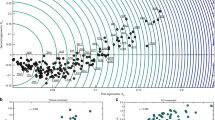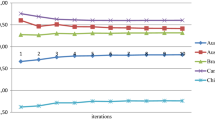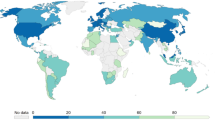Abstract
The effectiveness of the Triple Helix model of innovations can be evaluated in bits of information using the TH indicator of synergy based on information theory. However synergy, measured in bits of information can’t be straightforwardly interpreted in economic terms. The present paper is an attempt to establish a connection between synergy and other growth relating economic measure, such as complexity indices. The synergy distribution among 31 Chinese territorial districts is compared with corresponding distribution of complexity. The latter are calculated with three different complexity measures and on different datasets. Synergy and complexity show substantial linear relationship with each other. These complexity measures are further tested with their ability to predict future GDP per capita growth using employment, income, and investment data for 31 territorial districts of China and 19 industries. The results of regression analysis suggests that the accuracy of growth forecast can be substantially improved when exploiting links of different origin in bipartite networks in comparison with export oriented approach.





Similar content being viewed by others
Notes
https://ec.europa.eu/sfc/sites/sfc2014/files/2007/nace_rev_2.pdf. Accessed 25 January 2021.
http://data.stats.gov.cn/easyquery.htm?cn=E0103. Accessed 25 January 2021.
Eurostat/OECD (2009, 2011); cf. Laafia (2002, p. 7) and Leydesdorff et al. (2006, p. 186).
https://unstats.un.org/unsd/publication/SeriesM/SeriesM_34rev4E.pdf. Accessed 25 January 2021.
http://mcin.macrochina.com.cn Accessed 25 January 2021.
References
Abramson, N.: Information Theory and Coding. McGraw-Hill, New York, etc. (1963)
Antonelli, C. (ed.): Handbook on the Economic Complexity of Technological Change. Edward Elgar Publishing, Cheltenham (2011)
Arrow, K.J., Kurz, M.: Public Investment, the Rate of Return, and Optimal Fiscal Policy. The Johns Hopkins Press, Baltimore (1970)
Balassa, B.: Trade liberalization and “revealed” comparative advantage. Manch School 33(2), 99–123 (1965)
Beinhocker, E.D.: The Origin of Wealth: Evolution, Complexity and the Radical Remaking of Economics. Harvard Business School Press, Boston, MA (2006)
Bramwell, A., Hepburn, N., & Wolfe, D. A. Growing Innovation Ecosystems: University-Industry Knowledge Transfer and Regional Economic Development in Canada. Final Report to the Social Sciences and Humanities Research Council of Canada. Toronto (2012).
Etzkowitz, H., Leydesdorff, L.: The triple helix–-university-industry-government relations: a laboratory for knowledge based economic development. EASST Rev 14(1), 14–19 (1995)
Holland, J.H.: Complex adaptive systems and spontaneous emergence. In: Curzio, A.Q., Fortis, M. (eds.) Complexity and Industrial Clusters, pp. 25–34. Contributions to Economics Physica-Verlag, Heidelberg (2002)
Hidalgo, C.A., Hausmann, R.: The building blocks of economic complexity. Proc. Natl. Acad. Sci. U.S.A. 106(26), 10570–10575 (2009)
Ivanova, I., Leydesdorff, L.: Mutual redundancies in inter-human communication systems: steps towards a calculus of processing meaning. JASSIST 65(2), 386–399 (2014)
Ivanova, I., Smorodinskaya, N., Leydesdorff, L.: On measuring Complexity in a post-industrial economy: The ecosystem’s approach. Qual. Quant. 54(1), 197–212 (2019)
Krippendorff, K.: Information of interactions in complex systems. Int. J. Gen Syst 38(6), 669–680 (2009)
Leydesdorff, L.: The evolutionary dynamics of discursive knowledge: Communication-theoretical perspectives on an empirical philosophy of science. In: Glänzel, W., Schubert, A. (eds.) Qualitative and Quantitative Analysis of Scientific and Scholarly Communication. Springer Nature, Cham, Switzerland (2021)
Leydesdorff, L., Zhou, P.: Measuring the knowledge-based economy of China in terms of synergy among technological, organizational, and geographical attributes of firms. Scientometrics 98(2), 1703–1719 (2014)
MacGregor, S.P., Carleton, T. (eds.): Innovation, Technology, and Knowledge Management: Vol. 19. Sustaining Innovation: Collaboration Models for a Complex World. Springer, New York, NY (2012)
Maitah, M., Toth, D., Kuzmenko, E.: The Effect of GDP per capita on employment growth in Germany. Rev. Eur. Stud. 7(11), 240–251 (2015)
Mankiw, N.G., Romer, D., Weil, D.N.: A contribution to the empirics of economic growth. Quart. J. Econ. 107, 407–437 (1992)
McGill, W.J.: Multivariate information transmission. Psychometrika 19(2), 97–116 (1954)
Miller, J.H., Page, S.E.: Complex Adaptive Systems: An Introduction to Computational Models of Social Life. Princeton University Press, Princeton, NJ (2007)
Okun, A.M.: The Political Economy of Prosperity. Brookings Institution, Washington, D.C. (1970)
OECD. System Innovation: Synthesis Report. OECD Publishing, Paris (2015).
OECD. Elements for a new growth narrative. Draft report. SG/NAEC (2018)1. https://www.oecd.org/naec/SG_NAEC(2018)1_Elements%20for%20a%20new%20growth%20narrative.pdf (2018). Accessed January 25, 2021
OECD. GDP per capita and productivity growth. https://www.oecd-ilibrary.org/employment/data/oecd-productivity-statistics/gdp-per-capita-and-productivity-growth_data-00685-en (2021). Accessed January 25, 2021
Ourens, G., Can the Method of Reflections help predict future growth? http://sites.uclouvain.be/econ/DP/IRES/2013008.pdf (2013). Accessed January 25, 2021
Romer, P.: Increasing Returns and Long-Run Growth. J. Political Econ. 94(5), 1002–1037 (1986)
Russell, S., Norvig, P.: Artificial Intelligence: A Modern Approach. Prentice Hall, Englewood Cliffs, NJ (2002)
Shannon, C.E.: A Mathematical Theory of Communication. Bell Syst. Tech. J., 27, 379–423 and 623–656 (1948).
Solow, R.M.: A contribution to the theory of economic growth. Quart. J. Econ. 70(1), 65–94 (1956)
Swan, T.W.: Economic growth and capital accumulation. Econ. Record. 32(2), 334–361 (1956)
Tacchella, A., Cristelli, M., Caldarelli, G., Gabrielli, A., Pietronero, L.: Economic complexity: conceptual grounding of a new metrics for global competitiveness. J. Econ. Dyn. Control 37(8), 1683–1691 (2013)
Wessner C.W. & Wolff A.W. (eds.). Rising to the Challenge. U.S. Innovation Policy for the Global Economy. National Research Council. National Academies Press, Washington (DC) (2012).
Wilson, D., Kirman, A.P. (eds.): Complexity and Evolution—Toward a New Synthesis for Economics. MIT Press, Cambridge, MA (2016)
Yeung, R.W.: Information Theory and Network Coding. Springer, New York, NY (2008)
Acknowledgment
The author is grateful to Loet Leydesdorff for his valuable comments on a previous version of the manuscript and Kevin Dong for help in data collection. Inga Ivanova acknowledges support of the Basic Research Program at the National Research University Higher School of Economics (NRU HSE) and a subsidy granted by the Russian Academic Excellence Project ‘5-100’.
Author information
Authors and Affiliations
Corresponding author
Additional information
Publisher's Note
Springer Nature remains neutral with regard to jurisdictional claims in published maps and institutional affiliations.
Appendix
Appendix
Rights and permissions
About this article
Cite this article
Ivanova, I. The relation between complexity and synergy in the case of China: different ways of predicting GDP growth in a complex and adaptive system. Qual Quant 56, 195–215 (2022). https://doi.org/10.1007/s11135-021-01118-6
Accepted:
Published:
Issue Date:
DOI: https://doi.org/10.1007/s11135-021-01118-6




